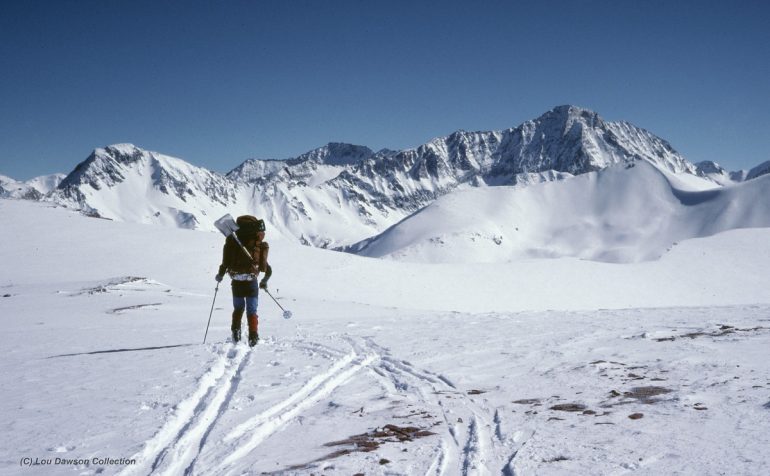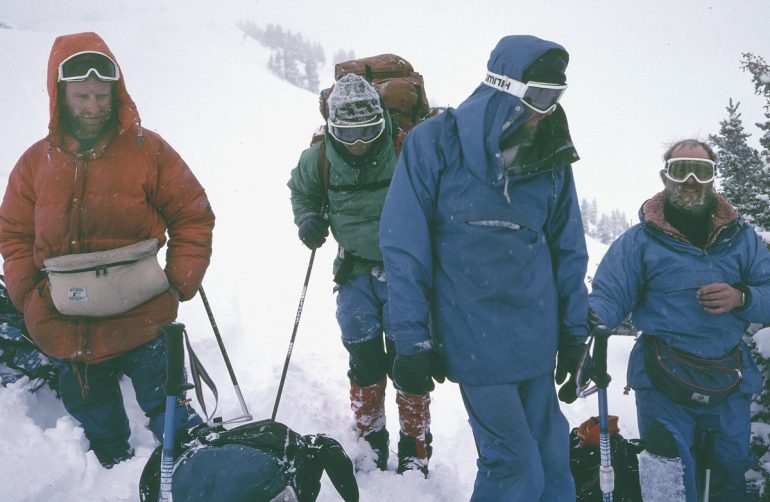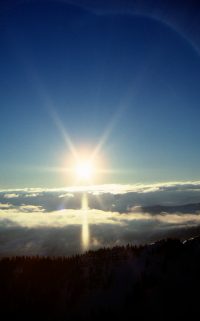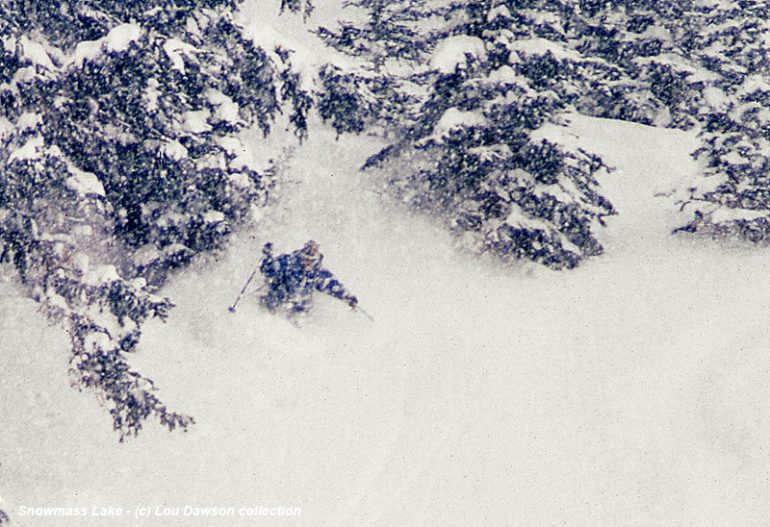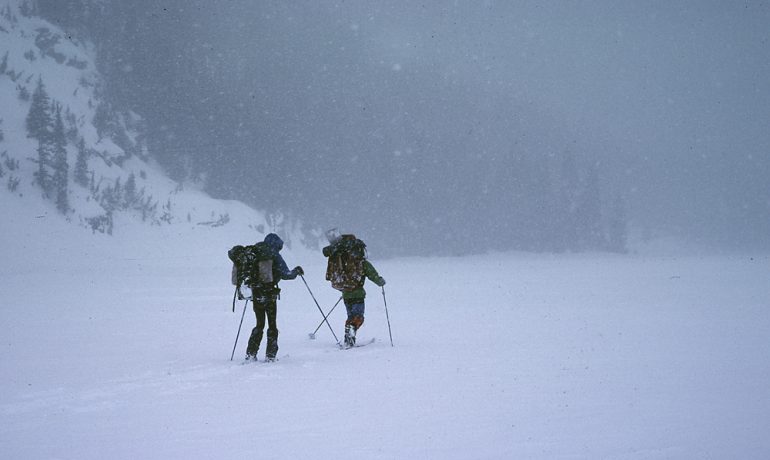It was audacious, about as challenging and risky as could be. I’m not sure it was ever fun. But we didn’t care about fun in particular — we were about pushing ourselves, testing against the mountains, seeing what doing so dredged up from our souls. And maybe hoping to excise a few internal demons.
Over a span of four years in the 1980s I organized three mid-winter ski traverses through the jagged, avalanche prone Elk Mountains of Colorado, south of Aspen. The ideal line ran more or less 50 miles on the highland spine of the range — and if conditions were right, would take two 14,000-foot peaks along the way.
Could such a thing be done in winter conditions, with Colorado’s notorious snowpack, and weather that in those days was nearly impossible to predict more than a few days out? There was only one answer: try it. So along with a variety of friends I did exactly that. In fact, I became obsessed and attempted the Elk Mountains Traverse three different times over the span of four years, with varying degrees of success — depending on how one defines it.
One of our 1980 traverse participants, Richard Compton, recently passed away (Read his Aspen Times obituary here). I had met Richard in 1967, at a boy’s mountaineering camp. We became friends, climbed together, and both worked as NOLS instructors. He was a heck of a skier — and a fine writer. I don’t remember how I convinced him to try the traverse. Perhaps I promised blue sky and fields of pristine powder. More likely, I just said something a 20-something mountaineer like Richard could not resist: “You’ll never do anything harder.” Either way, Richard’s participation made for good writing on his part. In memorial to Richard, with the permission of his estate, we publish his words below as a posthumous guest blog. Please enjoy! — Lou Dawson
SIX WHO DARED — Elk Mountains Traverse, Colorado, March 1980
Written by the late Richard Compton
The wind began to blow. Not hard, not steadily, just random gusts swirling spindrift into our hole. We dug deeper. The main blast passed over our heads but left its burden behind; it whispered down and wrapped itself around us, seeking our faces. I hunkered down on my pack, waiting.
“Eat until you’re full, then keep eating until you’re ready to puke. Then eat some more.” Thus spake the Mountain Man, and I had ignored him the night before, preferring to go to bed early and rise late. Only force feeding on crackers and Camembert at lunchtime had saved me from becoming a basket case. So I let the spindrift spin while the stoves muttered in their alcoves, waiting for the magic words:
“Brew.” “Swill.”
Gone were the moonlight, the magic of the day. My horizon extended as far as my mug and bowl. Ted came around with a bucket of swill. I offered him my bowl.
“This is great!” We looked at Frank and laughed. Globs of halfcooked pasta crawled across the bottom, while a few rubberized vegetables swam through a broth larded with parmesan and paprika. It was primordial, and it was hot.
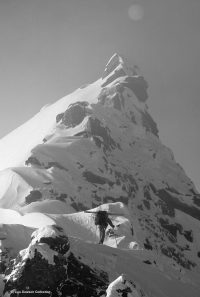
The route began with this spicy scramble, but for the most part was a trail breaking epic with promised but seldom delivered downhill rewards.
Snow. it was what we came here for, unpackaged, ungroomed, unbroken, uncontrolled snow. High and dry. Low and wet. Windslab, suncrust, crud, mush, mashed potatoes, slush. Steep and deep, fluff, corn and concrete. Only by embracing it all could one gain perfection, only by taking oneself to the mountain would one earn the passage to pure white flying in your face, pouring over your shoulders with every turn as your skis pump down, down, down to the heart of the mountain.
Appropriate thoughts for a perfect Colorado day, spring in the air, winter on the ground, blue white and evergreen uncomplicated by wind or cloud. We started up the Thomas Lakes road, headed for the east flank of Mount Sopris, the long ridge down to Capitol Peak, the steep passes and narrow valleys of the Elks’ heart: the broad, beautiful Taylor River valley leading out toward Crested Butte, eighty miles and two slogging weeks away.
Lou Dawson was somewhere out in front, finding the route, mastering the obstacles, setting the pace. Ted Kerasote was close behind, gnomish beneath his beard and broad, heavy pack, intent on every step of the way. John Quinn and Frank Coffee, smiling; Peter Kelley, running from his demons; myself, wandering, wondering, searching for the peaks.
We waned with the day; as the sun set we sprawled across the trail, dug out the stoves and settled down for a repast of sweet tea and greaseburgers. Greaseburgers! The ultimate low-rent gutbomb. Winter Outward Bound’s most notorious test of intestinal fortitude. Lou was an evangelical exponent of their caloric virtues: “four a day keep hypothermia away.” To create: Split one English muffin, soak in melted butter. Top with two strips limp bacon and a large glop of strawberry jam. Put on your best Ronald McDonald grin and serve to the unwary. Guaranteed to make a hard man out of any wimp.
The hard men come from Scotland, where they pick their way up the steep ice gullies of Ben Nevis in Arctic gales. Full conditions they call it. You haven’t really done a route until you’ve done it in full conditions. We joked about it that night, as the full moon glazed over and a few flakes began to fall.
“Well lads, looks like we’ll be able to complete the route in full conditions.”
“Aye, Jimmy, things are looking up.”
The route was as hard as Lou could make it, west to east down the full length of the Elk Range, skirting four fourteen thousand foot peaks, climbing and skiing two more – during the first two weeks of March, the snowiest time of the year. It was a major expedition to the back yard; in July the same trails would be swarming with hikers and backpackers and sheep and cattle would be grazing across the ridges and valleys. In two solitary weeks we would never be more than a day’s ski from Aspen or one of its outlying settlements, striving only to experience the mountains as nakedly as our physical continuance and this confined wilderness would allow.
For shelter we carried only bivouac sacks – nylon envelopes into which we slipped our bags and sealed ourselves up for the night, and lightweight shovels for digging caves. Our food had four outstanding qualities – it was light, cheap, fast-cooking, and caloric.
It only had to taste good enough to get past the tongue. On skis, clothing, and packs we indulged ourselves — lightweight easy turning skis with bindings that hinged at the toe for the flats and hills, then locked down at the heels for going down. Mohair climbing skins and soft plastic ski boots with vibram soles to go with them. Polypropylene, pile and goretex to cover our bodies, contoured, fully adjustable internal frame packs to lug our fifty pounds of food, fuel, stoves, sleeping bags and other energy maintenance devices.
* * *
It snowed only eight inches the first night, and a half dozen more the second day. Fresh and light, it spiced the experience, blessing a small group of friends as they traveled upward – until we crossed the threshold. A jumble of boulder-sized blocks of snow snouted down a gully between the last two stands of trees. Somewhere up above, invisible through the fog and snow, a large slab had let go a few days before, leaving us this indelicate reminder of where we were. One by one we picked our way across and huddled under a stout old fir, one of the survivors, waiting for the storm to lift enough to show us the way onto the ridge.
Up there the trees offered no comfort at all, blown and twisted into caricatures of themselves, rimed with hoarfrost, they pointed out our own intrusion. The snow searched out the folds and crevices of our clothing, collected along the seams in our packs, doing its job of dissolving us back into the ocean. We were fully engaged in thwarting it, subverting it, converting it to our ends — digging caves, building walls, melting it down to warm and nourish our own bodies. I moved frantically, struggling to create a safe niche for myself in this hostile world: a narrow shelf deep inside the drift for my bag and me that would shelter us from the grey night.
I noticed that the others moved more slowly, were more relaxed, more confident of things working out. Ahead of us the ridge narrowed to a rocky pinnacle, behind that all we could see was a cliff on the east and an abyss on the west. I was not looking forward to the next day and, disgusted with the tasteless evening fare, crawled into my hole without waiting for seconds.
The clouds rolled back during the night, leaving us spectacularly isolated in the morning sun, an island of consciousness in a billowing golden sea. A brilliant sundog reached deep into the valley; we watched it slowly fade as we hurried through breakfast, joking, laughing, snapping pictures, eager to be on our way.
Making good on its promise, the whole day became a graphic extravaganza as we quickly passed the pinnacle and cruised over miles of gentle peaks and cols on easy windpacked snow. No wind, no clouds, no trees to mitigate the impact of sun, snow, and shadow.
Capitol’s north face loomed higher and higher over bowls begging to be ravished, but we had miles to go to make our goal and the ridge unrolled forever, sucking up the hours until cruising became pushing, became a mad race with the sun up the last summit, the wind tearing at our backs. We picked our way down in the dark through suncrust and rocks, eeking out a few powdery turns in the basin as we searched for a bivvy. Finally a little knoll appeared, bathed by the full moon rising behind Mt. Daly. Exhausted, we dropped our packs and began to make ourselves comfortable, while Ted set up his camera for a shot of the moonrise.
We lay late in our bags, waiting for the sun to reach us, breakfasting slowly (two greaseburgers, slightly soggy), forgetting the spindrift nightmare as we soaked up warmth and calories. Full conditions were no joke. Today, at least, we’d do some skiing. There was a lot of vertical between where we lay and our cache at Snowmass Creek. Eventually we heaved ourselves over the edge of the knoll and slashed our marks across the moist, cruddy gully, glad for the same heat that was ruining the snow.
Having done its dirty work, the sun disappeared behind a fast moving overcast, leaving us cold and alone again as we marched into Capitol’s granite maw. We escaped with a short, hard climb over Daly Pass, reaching the top just as the storm hit, riding on a furious blast of wind and burying us in invisibility.
More Zorro turns. North to the rocks, kick turn, traverse a hundred feet south until the snow got soft and deep enough to ski – and to slide – then back again. This was skiing? Frustrated beyond endurance, I cut loose, deciding to make some turns, no matter what, make them right, make them good and clean and round in spite of the whiteout, the fifty unaccustomed pounds on my back, my half-recovered sprained ankle. Show how good I was, show this lousy messed up foggy mountain who was boss. One turn, two turns, by the third turn my weight was off the skis and into the snow. Cursing the mountain, cursing myself, cursing the others for their plodding good sense as they passed me by, I struggled to my feet again, cursing my pack. Humiliated, but unrepentant, I straggled in to lunch, ate quickly, and took off. Loneliness and exhaustion, at least, would relax me. Let the others cook and clean up, they were already doing fine.
Somewhere in the dense, moss-hung woods I lost an overmitten that was tied to the outside of my pack. Peter picked it up and returned it to me smiling. We built a bonfire and roasted our cached steaks over the coals, then wolfed them down rare and smoky in the dark, full of animal glee, mocking the civilized world just beyond the next hill.
The next day it began snowing in earnest — a few flakes, a squall, then silence as big fat ones came down endlessly, slowly burying the trees. It was beautiful, annoying, and in the end peripheral. Our bodies were stretched to their limits; the weather only made us go faster or slower. We were already there — keep going and eat, eat and go on. Keep going until you can’t go any more; stop long enough to force down another dose of crackers, cheese, water, tuna, gorp — whatever looks least unappetizing at the moment. Then go on again.
Life was so simple, and so profound. Everything made a difference — every degree Fahrenheit, every percent humidity, every flake on the trail, in my face, every stride, every ounce of gear, every calorie in and out counted. Every stray thought, every twitch of muscle added or detracted from reaching the goal.
* * *
Snowmass Lake. A trickle of water flowed from the base of a six foot drift and down the hill. John, a long line tied to his water bottle, was methodically fishing up fresh water, saving us time and fuel over having to melt snow. Down by my knees a Forest Service sign kindly advised me to camp only in designated sites in order to minimize my impact. No advice for the storm, which was quietly obliterating all trace of me at the rate of more than one inch per hour. Somewhere out there was a mountain.
I reflected for a moment as I watched Lou and Peter crouching over the stoves. “Now I know what it’s like to be an alcoholic, living from one brew to the next.”
That earned me a hot buttered rum. I savored it, then John and I set about digging a fire pit, an enclosed space from which to strike back at the cold and damp. Several rounds of swill. Quesadillas, sort of. Couscous and something. Endless varieties of the same old shit. Lou and Ted cornered the stash, calculating our endurance. Enough to make it to Gothic and the next cache. I wrangled enough back to create the ultimate disguise for instant mashed. Frank liked it, everyone ate it.
A memorable evening. We sat back on our snow benches, brewing, carefully shrugging off the cold blanket settling over us, enduring the random barrages of tree bombs, micro-avalanches off the branches that announced themselves with a dull thud, followed by a curtain of dust that filled our eyes and noses and brew mugs. We were under siege. Nothing to do but sit it out. Tea, cocoa, more tea.
Next morning was just like the evening, only getting lighter instead of darker. Maybe because another foot of sky had fallen. Listlessly we ate breakfast. Finally Lou made the move. Snowmass Mountain. Was he crazy? Seen a vision? We followed. Maybe sheer bravado would break the weather.
Until we hit the lake.
Lou was standing a hundred yards out, contemplating the void. I followed and passed him, still wondering, still curious.
“Which way is the mountain?”
“Straight ahead.”
Inspired, I dogged on to the middle of the lake, waiting for the miracle to strike, for the sky to clear, for a safe route up the mountain, for three thousand vertical feet of waist deep powder. I waited, watching the snow pile up on every horizontal facet of my body, a quarter inch in five minutes.
The mountain refused. We collapsed, laughing at our hopeless effort, drunk on the weather, OD’d on snow, stoned kids drowning in paradise. Well, we had to find something to ski.
Half an hour later we stood on top of a chute on the south shore, cutting loose two foot slabs that silently vanished into rough tongues of snow, then followed them down into the deep, deeper, in the face, over the head stuff of our dreams. Another run, a longer one, a better one. The last one. Somebody went too far left and cut loose a pocket slide, sending Frank for the ride of his life, burying Ted up to his waist. He dug himself out and we headed home to wait again.
The storm broke in the morning. Eternal optimists, we greeted each ray of sun with shouts and cameras waving at the freshly lit tree tops. They were so gorgeous. This time it had to be real, the rest of the trip would be ours. An overdose of greasburgers slowed my enthusiasm, but there was no denying the warmth.
Nor the residue of two-day’s storm. Heavy knee-and-deeper snow wasted one leader after another as we struggled up out of the swamp through the rock bands toward Buckskin Pass. I bent to it with a will, nothing left to hold back. At treeline Lou broke away from the slogging pack and led out to the top of the pass. Behind Snowmass — finally visible — loomed an awesomely black cloud. Somehow I convinced myself that it would stay there and returned to counting the days, the passes, the steps in front of me. Seven more days. Five more passes. Today Buckskin, tomorrow Maroon. A night in Gothic. Long haul over Copper to Conundrum Hot Springs (a hot bath at eleven thousand feet!). Castle Peak, Ashcroft, and Taylor Pass.
But Buckskin wouldn’t go. Ten inches of fresh snow on top of an icy crust put the avalanche danger way beyond our control. Slowly we reversed, traversing back the way we’d come, already dreaming of the first bar we’d hit tomorrow, clean clothes, endless supplies of food and drink, downhill all the way.
That night it really dumped. Camp looked like a polar Khe Sanh, trenches, tunnels, gear strewn randomly about. We emptied our foodsacks into the swillpots and toasted the storm with the remainder of the brandy.
May, I was thinking. Come back in May. Lightweight three-pin ski gear, sunshine, and corn. Have a good time.
Lou spoke up, “We’ll do it in January. It’s colder, we’ll need more radical gear but there’s less snow. And the weather’s better.”
The weather was fine with me, I knew I could handle it with my Goretex and Polarguard bag. I plopped down in the middle of the gully and let the storm bury me; I was already safe and sound, almost home.
-Richard Compton, 1981
(Note from Lou and the editors: This article originally appeared in a now out-of-print regional Colorado publication. It is reprinted here by permission of Richard Compton’s estate. The photos above were shot by a variety of traverse participants. Most were made by Lou and Richard, but lack specific credits written on the slide mounts. All were given to Lou with publication rights, and are credited to the “Lou Dawson Collection.” Several companions and I finally made the complete traverse in February 1982, finishing at the Ashcroft townsite. The traverse has since been completed several times. The first repeat I know of is when John Doyle, Doug Bitterman, Dan Bunta and Andy Ward hit it in spring of 1989, with good spring-snow conditions. I’ve always been envious of the skiing Doyle and his friends did on that good, avalanche safe snow, but I treasure my memories of our crazy winter attempts.)
Beyond our regular guest bloggers who have their own profiles, some of our one-timers end up being categorized under this generic profile. Once they do a few posts, we build a category. In any case, we sure appreciate ALL the WildSnow guest bloggers!

